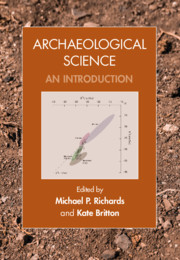Book contents
- Archaeological Science
- Archaeological Science
- Copyright page
- Contents
- Figures
- Tables
- Contributors
- Acknowledgements
- Part I Introduction
- Part II Biomolecular Archaeology
- Part III Bioarchaeology
- 7 Human Osteology
- 8 Dental Histology
- 9 Geometric Morphometrics
- Part IV Environmental Archaeology
- Part V Materials Analysis
- Part VI Absolute Dating Methods
- Index
- References
9 - Geometric Morphometrics
from Part III - Bioarchaeology
Published online by Cambridge University Press: 19 December 2019
- Archaeological Science
- Archaeological Science
- Copyright page
- Contents
- Figures
- Tables
- Contributors
- Acknowledgements
- Part I Introduction
- Part II Biomolecular Archaeology
- Part III Bioarchaeology
- 7 Human Osteology
- 8 Dental Histology
- 9 Geometric Morphometrics
- Part IV Environmental Archaeology
- Part V Materials Analysis
- Part VI Absolute Dating Methods
- Index
- References
Summary
The ability to objectively compare shapes of skeletal remains, such as skulls and teeth, or artefacts, such as stone tools, is central to many questions in archeology and palaeoanthropology. Over the last decade, geometric morphometric (GMM) techniques have revolutionised the statistical analysis of shape and form. Statistical shape-analysis can be a helpful tool for answering many archeological questions. One might, for example, be interested in the population dynamics associated with changes in material culture. Studying the human skeletal remains from different archeological stratas using geometric morphometrics can provide insights into the population history. Based on artefacts alone it is often impossible to determine whether a cultural change was linked to the replacement of a local population, or whether this new set of behaviors and skills developed locally.
- Type
- Chapter
- Information
- Archaeological ScienceAn Introduction, pp. 198 - 212Publisher: Cambridge University PressPrint publication year: 2020



